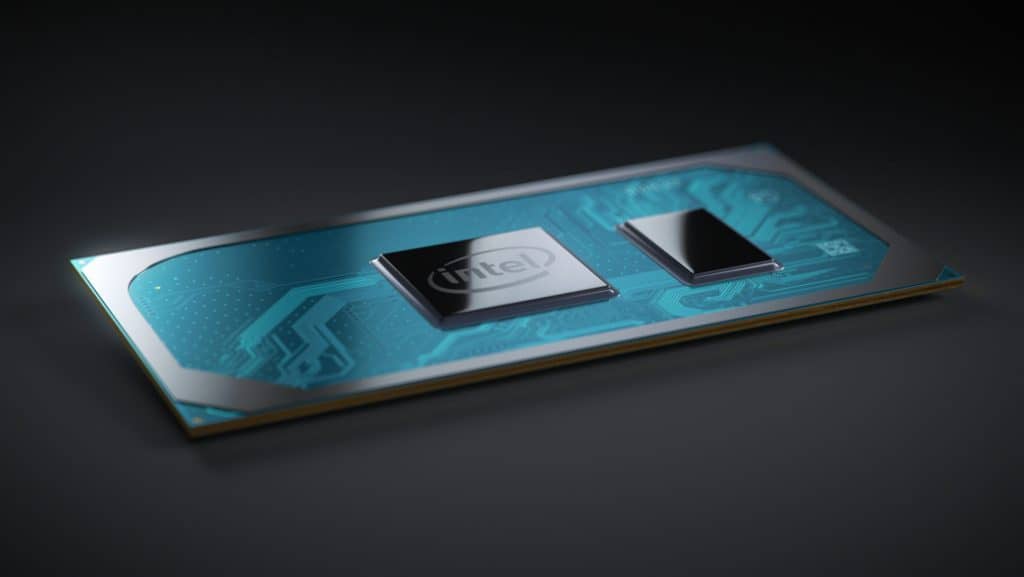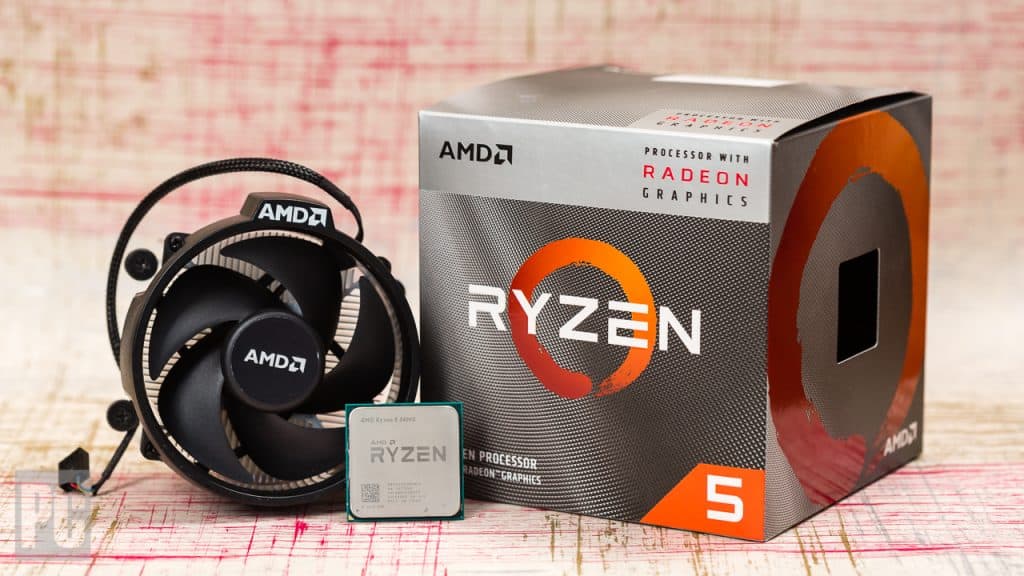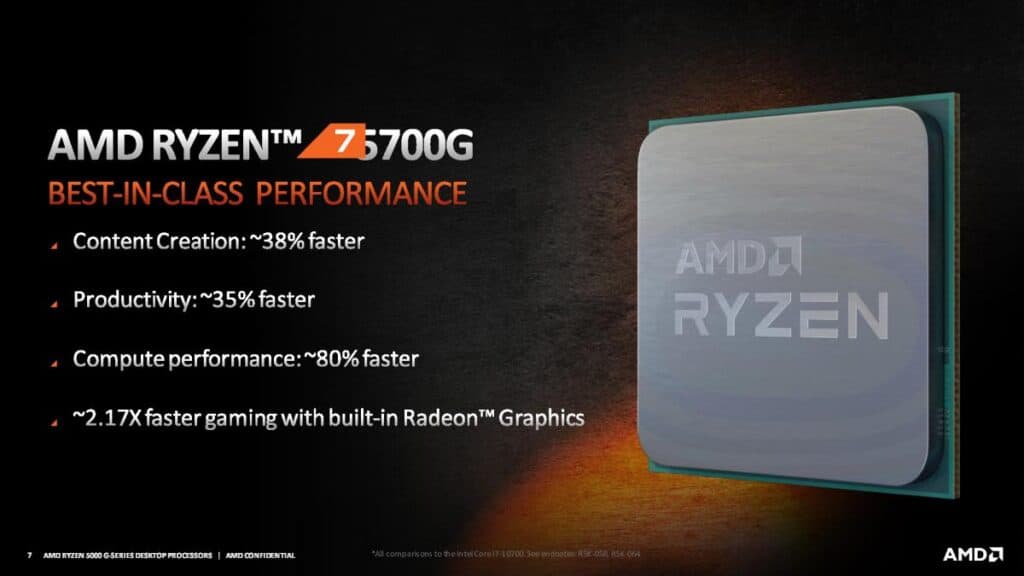If you’re building a new PC, the CPU you choose will be one of the most important decisions you make. Likewise, if you’re buying a pre-made PC or laptop, looking at the CPU should be one of the factors that drive your decision the most.
When comparing different processors, you’ll often find them referred to as CPUs or APUs. These two acronyms represent different types of processing units that many users looking to buy a gaming PC on a budget will run into.
What are the differences between a CPU vs APU, and which one should you be looking at?
Keep reading our APU vs CPU comparison to find out!
APU vs CPU – A short summary
CPU (Central Processing Unit) is a typical processor in charge of receiving and executing instructions from software. An APU or Accelerated Processing Unit is AMD’s brand name for processors that offer powerful integrated graphics. You might think of an APU as just another CPU from AMD with integrated graphics, but the performance of modern APUs is impressive.
Whether you need a dedicated graphics card (GPU) or not will depend on your gaming needs and budget. It’s generally accepted that modern AAA games can’t be played properly on a PC with an APU, so you’ll need a CPU paired with at least a budget graphics card.

Still, newer APUs push the limits of what’s possible with integrated graphics, so we might be nearing a time when you can run more recent games on mid-to-high settings even with an APU. Additionally, we’re all currently experiencing a sort of a GPU shortage, which is why many people are looking into high-end APUs as potential solutions to the problem.
Let’s get into these two terms and understand their differences.
CPU vs APU – The key differences
What’s a CPU?
A regular CPU is your PC’s main processing unit. It takes instructions from all software running on your PC and sends those instructions further. A CPU without integrated graphics will need a GPU (Graphics Processing Unit or graphics card) not only to run games but to show any kind of image on your screen.
A CPU is a standard processor that most people think of when mentioning processing units. It enables your PC to interact with all of the software you have installed. A processor interprets the instructions from these programs and creates an output that we interface with.
However, a processor isn’t able to produce images on its own without a GPU. A GPU handles graphics-related content, including video rendering, games, and essentially any content that requires a sophisticated image.
That’s why a lot of low-to-mid-range processors have integrated graphics. People looking for a simple PC/laptop only need a GPU that allows them to look at images and play videos – which is something that a cheap integrated GPU is capable of. We could even say that most consumer PCs and laptops have CPUs with integrated graphics.
AMD’s processors with a “G” in their product name have an integrated GPU, while Intel’s processors with an “F” in their name don’t have an integrated GPU.
CPU Pros:
- The best processors on the market are usually CPUs (not APUs)
- A better choice for high-end gaming
- Even a mid-range CPU + GPU is better for gaming than high-end APUs
- Better for high-end productivity and multimedia tasks
CPU Cons:
- More expensive
- Heavier and more energy-consuming
What’s an APU?
An APU, on the other hand, features both a CPU and a GPU on the same die. The obvious benefit of an APU is that it requires less space, which is why most mainstream laptops come with integrated graphics. APUs are also generally less expensive and consume less energy than a CPU.
Once known as Fusion, APU is AMD’s marketing term for processors that act as a CPU and a GPU on a single die.
The Fusion project was started in 2006 when AMD acquired the graphics chipset manufacturer ATI and started working on a chip that would offer both a CPU and a GPU. The first APU was released in 2011 – it was codenamed Llano and featured a Radeon HD 6000-series GPU.
Today, AMD offers some of the best CPUs with integrated graphics on the market. The company has leveraged its experience in the GPU market with Radeon GPUs and made some impressive APUs for a fair price. Chips like Ryzen 5 3400G have integrated Vega 11 graphics and feature high base clock speeds, lots of cores and threads, and a lot of cache memory.

Meanwhile, Intel also developed its own integrated solution, Intel HD (later rebranded to Intel UHD), in 2010. The high-end versions of HD graphics are now known as Intel Iris Plus, and it’s found in Intel’s best CPUs with integrated graphics.
Since the early 2010s, the acronym APU has caught on, so it’s now frequently used to describe processors with integrated graphics, no matter the manufacturer. So, you’ll often hear people using “APU” as a catch-all term rather than referring to AMD’s specific product line.
Unfortunately, while today’s APUs are much better than those produced as recently as five years ago, they’re still no match for having a dedicated graphics card.
APU Pros:
- Lighter and more portable
- Less expensive
- You don’t need to buy a separate GPU
- More energy-efficient
APU Cons:
- Doesn’t support high-end gaming
- Not enough high-performance options
Which is better for gaming?
The question should really be rephrased to: “What’s better for gaming – an APU or a CPU + GPU combo?” since a CPU by itself won’t be able to produce any sort of sophisticated image, let alone run games.
The answer to this question is simple: a CPU combined with a budget GPU will outperform some of the best APUs available. Still, the CPU + budget GPU combo will cost you more than a high-end APU, so you need to assess your priorities and see how you want to spend your money.
Let’s look at an example.
The GeForce GTX 1050 is a dedicated GPU from Nvidia that is by no means a high-end graphics card: it will run you between $200 and $300 brand new. However, even the GTX 1050 convincingly outperforms the Vega 11 found in AMD’s Ryzen 5 3400G.
The gap between Vega 11 and Intel’s Iris Plus found in the i7-1065G7 is even wider. This tells us that AMD’s integrated graphics are far superior, and Intel’s integrated graphics aren’t even close to a budget dedicated GPU.
The comparison above doesn’t include AMD’s latest APUs like the Ryzen 7 5700G that really push the limits of integrated graphics. However, these APUs can come really close to some budget GPUs.
Which gamers should get an APU?
All of this doesn’t mean that an APU is a subpar solution if you’re into games. It all depends on your budget and the kind of games you’ll be playing.
If you’re looking forward to the latest AAA titles on decent settings, an APU will most likely be underwhelming. While things have been developing in this field, modern games keep pushing the envelope for visual effects and realism. You’ll notice a significant drop in FPS when playing an AAA game on an APU, on settings like 1080 medium.
On the other hand, less demanding games like League of Legends, Fortnite, and Rocket League will run on an APU with no problems.
To summarize, casual gamers and those that play lighter games should be completely fine with an APU. The same goes for those with a limited budget and don’t mind playing AAA titles on lower settings.
Which gamers should get a CPU with a GPU?
If budget isn’t an issue, you should go for a CPU + GPU combo in most cases. As shown above, even reasonably priced GPUs will give you much better performance than an APU.
Furthermore, even modern games don’t require potent processors – a hexa-core chip will be more than enough. This means you can go with a mid-range CPU and a budget GPU, save some money, and still get a great machine that can run AAA titles. Bear in mind, this will still end up costing you more than an APU, but you can find deals or buy a used GPU online.
To summarize, always try to go for a CPU and GPU if you consider yourself a gamer and your budget isn’t heavily restricted.
The best APUs on the market
If you’re looking into APUs, you probably want to know which ones are the best of the best.
Once again, we’ll reiterate that AMD is the absolute leader in this field. If you look at the top available APUs right now, at least 7/10 will be from AMD’s catalog. Intel has been making moves with its Iris Plus integrated graphics, but AMD’s latest APUs are still an order of magnitude better.

With that covered, here are the best APUs on the market right now.
- Ryzen 7 5700G: we can probably call the 5700G the best CPU with integrated graphics in the world right now. It’s an 8-core, 16-thread processor with a 4.6 GHz max boost clock speed and a very capable Radeon RX Vega 7 graphics engine.
- Ryzen 5 5600G: a notch below the 5700G, Ryzen 5 5600G is still a powerful processor at a highly affordable price. It offers 6 cores and 12 threads, along with a solid boost clock speed of 4.4 GHz.
- Ryzen 5 3400G: for a while, the 3400G was the absolute king of APUs. It packs a powerful Vega 11 integrated graphics solution, along with 4 cores, 8 threads, and a boost clock speed of 4.2 GHz.
Frequently Asked Questions
Finally, here are some questions that users seem to have when researching CPUs, APUs, and the critical differences between the two.
Is APU better than CPU?
An APU will be much more affordable and energy-efficient than a CPU and a dedicated GPU, but that’s about it for APU’s benefits.
A CPU + GPU combo will perform much better, both when it comes to gaming and productivity. Photo and video editing programs and 3D modeling software will all work better with a dedicated GPU.
However, the mentioned Ryzen 7 3700G, combined with lots of RAM, will be no slouch for productivity and multimedia programs.
Is an APU enough for gaming?
If you’re looking to play the latest games on solid settings, then no – an APU won’t be better for gaming than a CPU combined with a GPU. Even moderately-priced GPUs and CPUs will outperform high-end APUs when it comes to the latest titles.
However, if you’re interested in playing eSports games or you don’t mind playing newer titles on lower settings, an APU will do just fine. It will need to be a high-end APU, but you’ll still save money.
Is an APU processor bad?
An APU can’t match the performance of a CPU + GPU, but it’s by no means a bad processor. You just shouldn’t expect a certain level of performance from it, especially when gaming.
That said, some of Intel’s older processors with UHD graphics are dangerously close to bad for any sort of gaming or complex computing.
Is Ryzen an APU or CPU?
Most Ryzen processors are CPUs. Their APUs will have “G” at the end of the model name, as in “Ryzen 7 5700G”.
APU vs CPU – the conclusion
As you can probably tell from our APU vs CPU comparison, an APU is rarely an entirely satisfactory solution, particularly for gamers. Although we’ve seen a lot of progress from both AMD and Intel, the physical limitations of having both a CPU and a GPU on a single die still prevent us from enjoying a great gaming experience on a budget.
That said, an APU will be a perfect solution for mid-range users looking for an excellent CPU for basic and complex computing tasks. A high-end APU will run most eSports games with ease, as well as productivity software.
If budget isn’t a problem, always try to go for a CPU and a dedicated GPU. These will give you a noticeable performance boost, even if the GPU in question is a budget option. The difference will be most apparent in gaming, where a GPU can give you a 30-40% boost in FPS when it comes to the latest AAA titles.